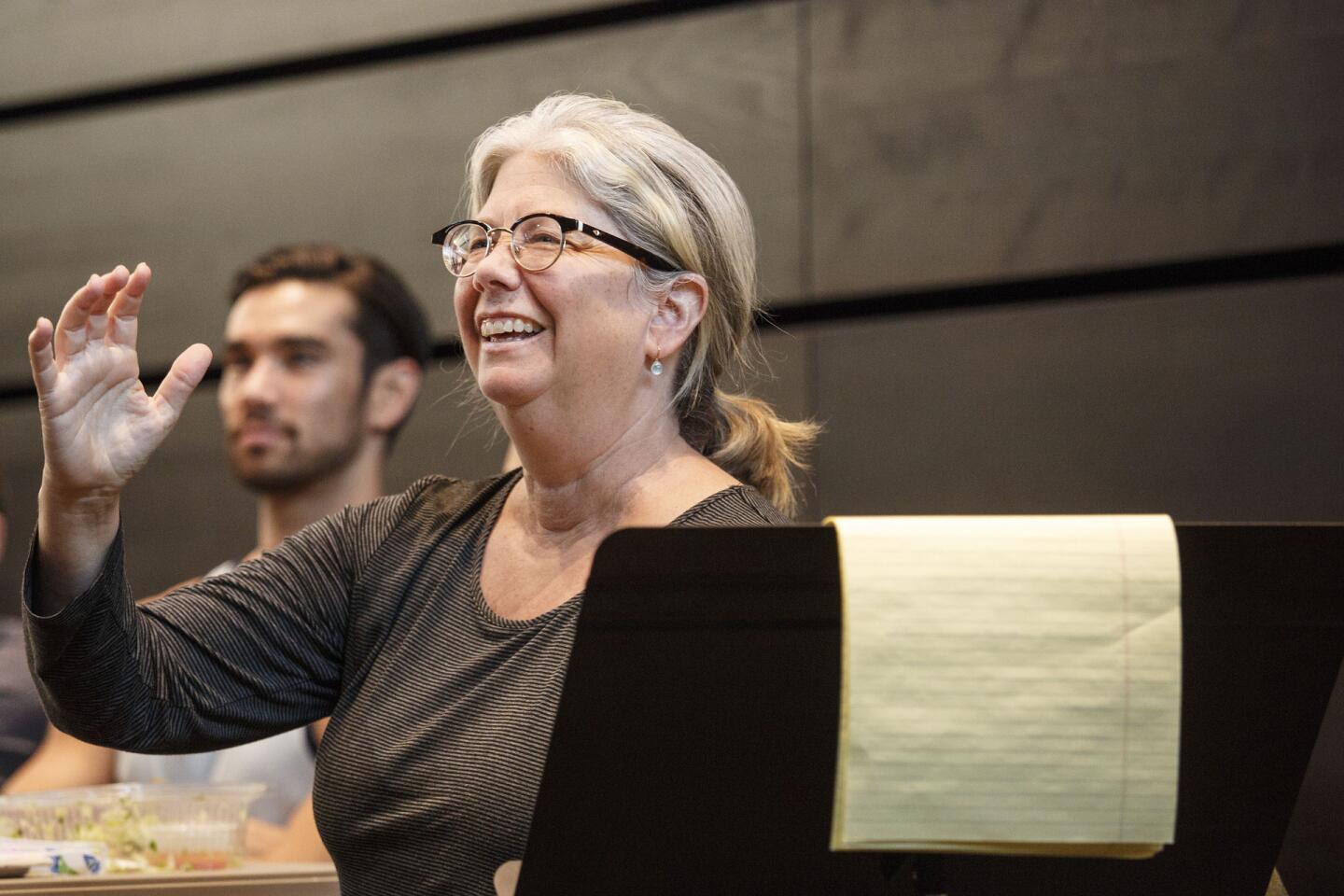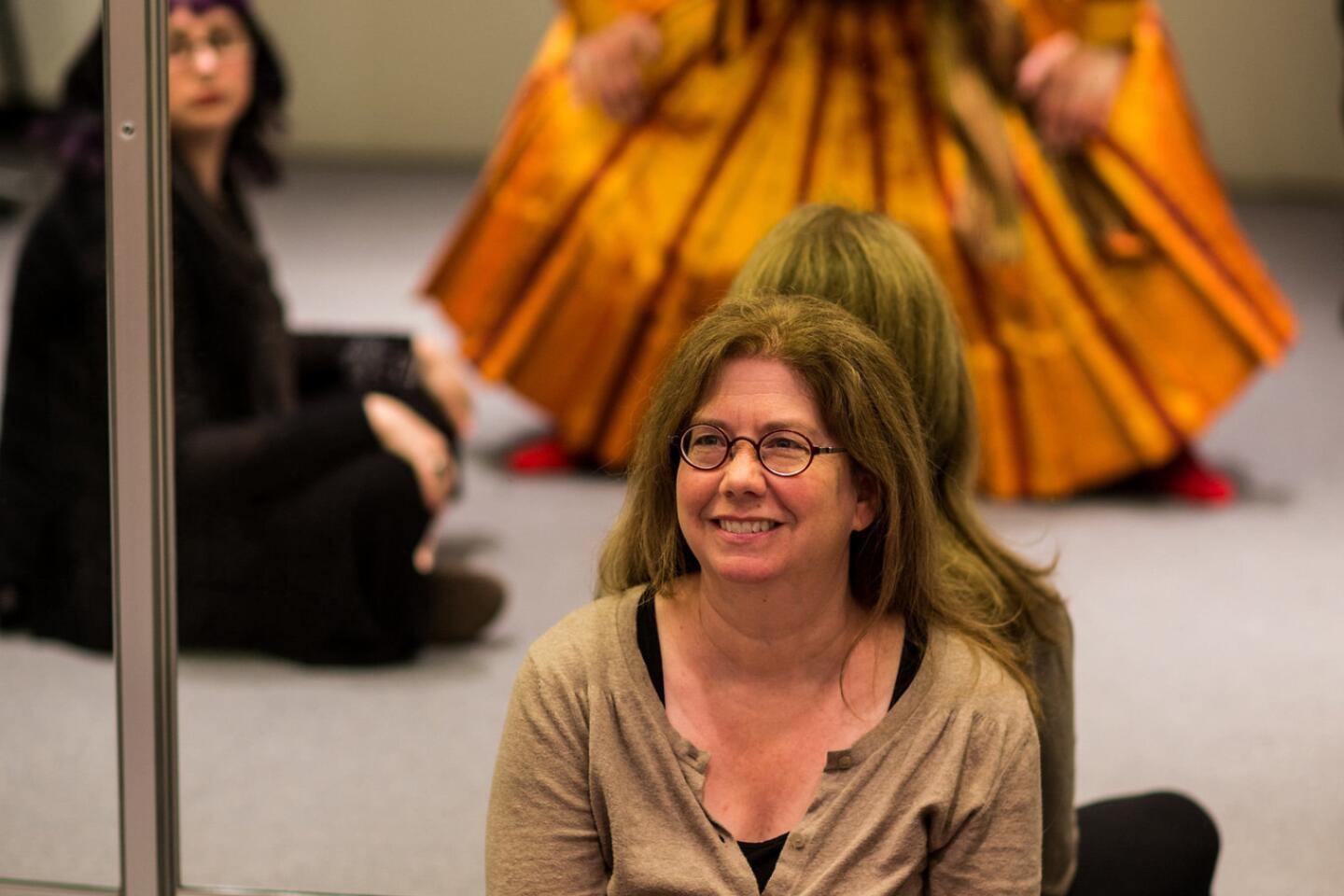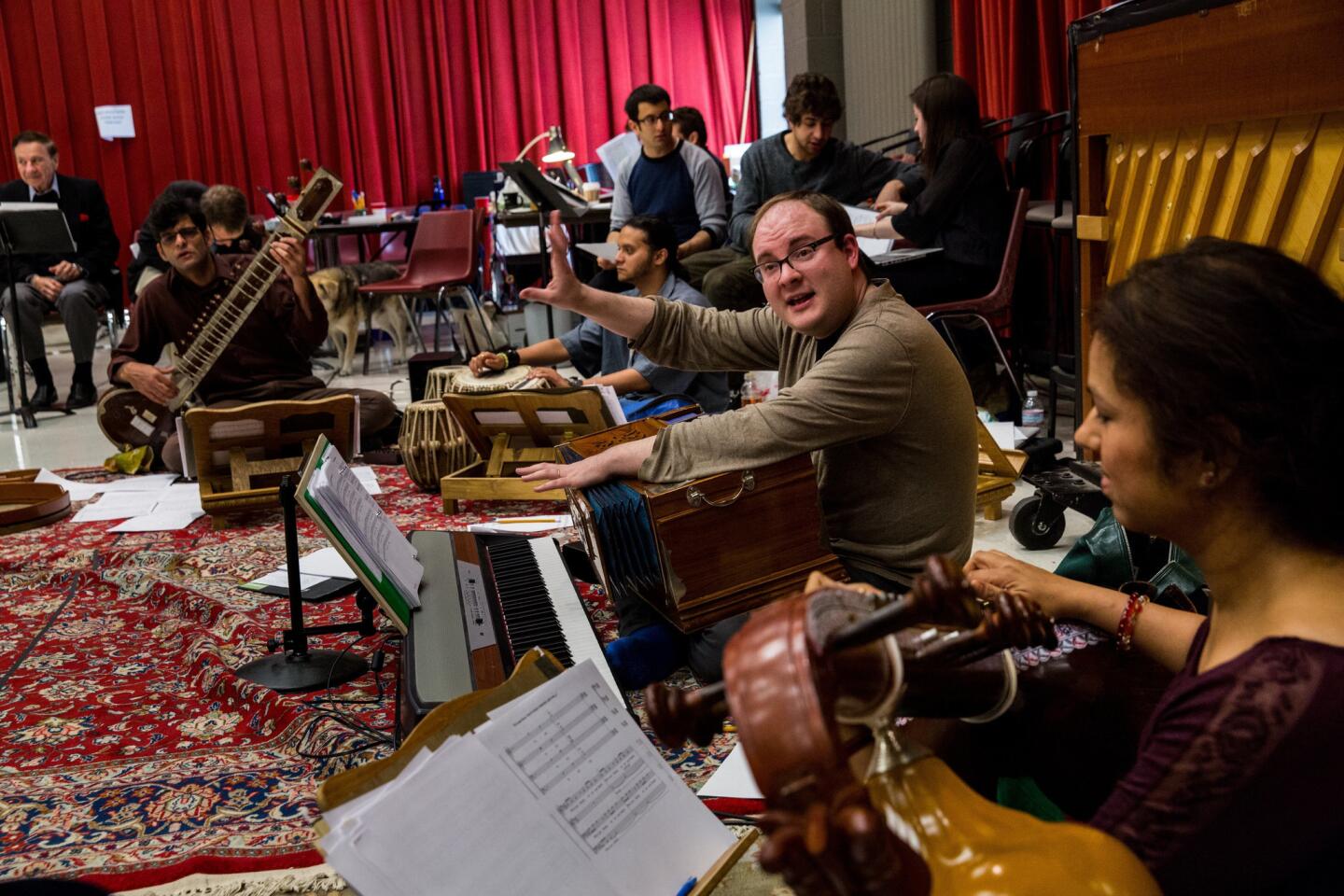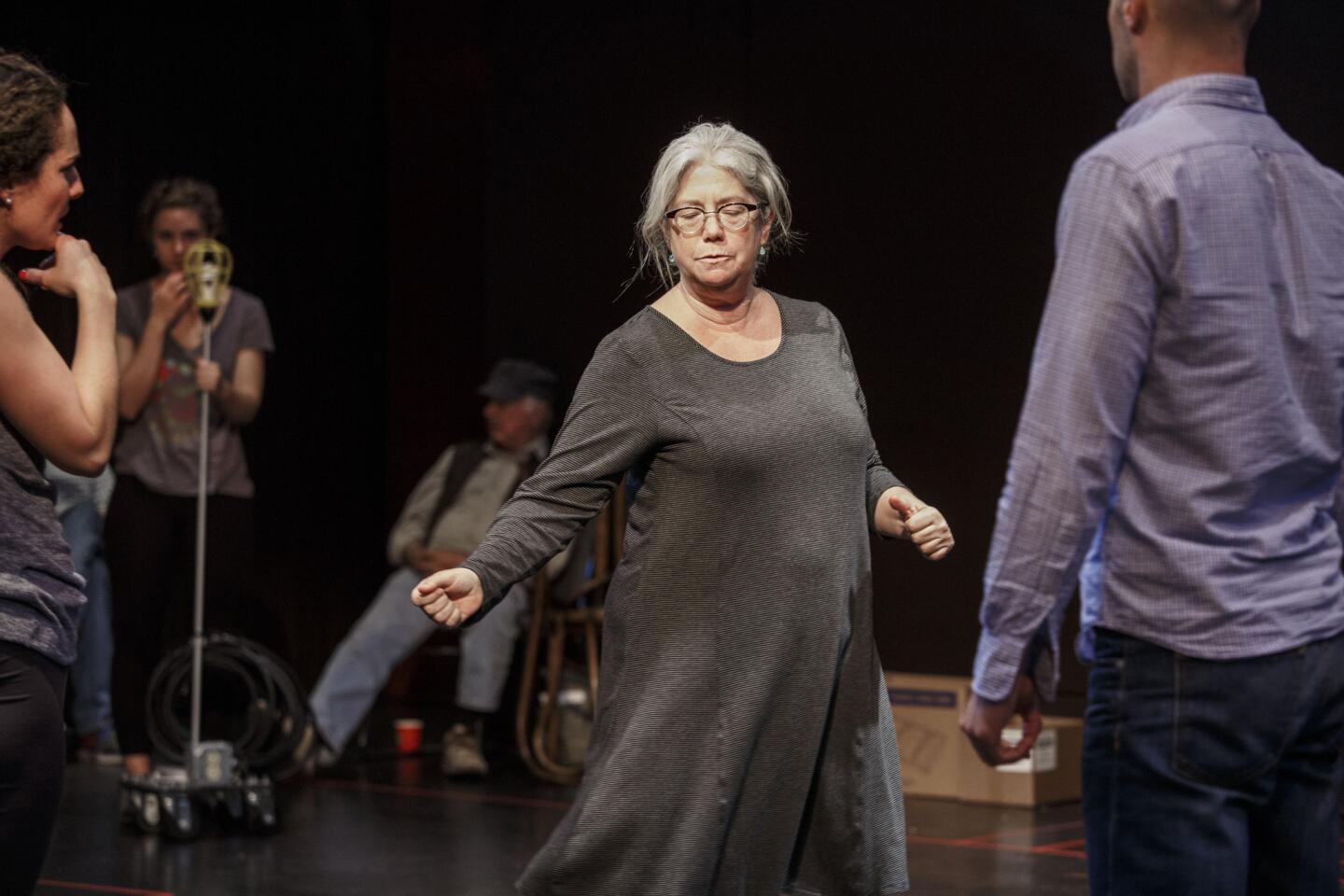For Mary Zimmerman, overseeing ‘Guys and Dolls’ at the Wallis, it starts with imagination
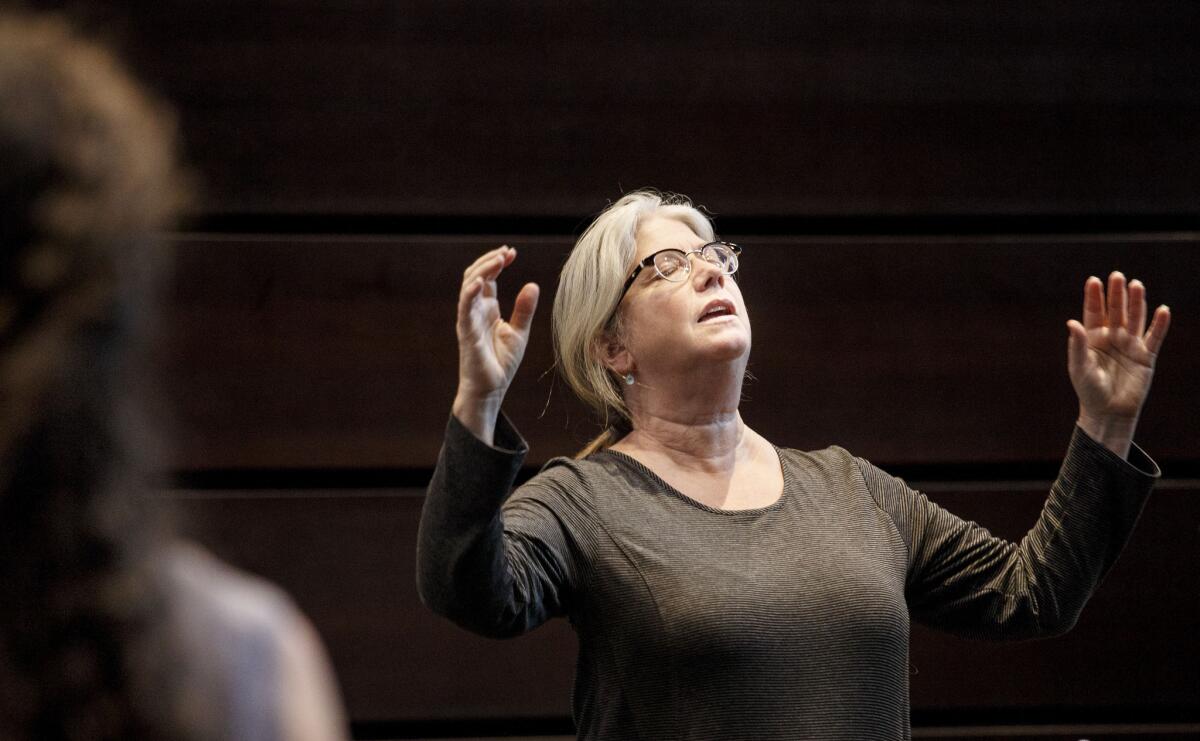
Theater director Mary Zimmerman rehearses her production of the musical “Guys and Dolls” at the Wallis Annenberg Center for the Performing Arts in Beverly Hills.
In the center of the rehearsal room stands a cluster of men of all ages and sizes. They’re in street clothes, but from their loose postures and colorful New York patois, they are instantly recognizable as the semi-shady, thoroughly lovable gamblers of “Guys and Dolls.”
Director Mary Zimmerman has microscoped in on about 10 seconds of comic movement and is fine-tuning from the sideline.
She instructs the clump of gamblers, along with an insistent police lieutenant and a nightclub chanteuse who’s been waiting 14 long years to walk down the aisle, to creep two steps closer, then another two steps closer, to the reluctant groom, who backs an equal number of steps away. The jittery fellow faces a human wave that is about to crash on him, forcing him to set a date, unless he can quickly think of a way to delay yet again.
See the most-read stories in Entertainment this hour >>
The actors have a high time with this, egged on by giggles from the production team and cast mates watching from the periphery. One laugh — high, rat-a-tat — rings out over all the others. It is Zimmerman’s.
She may be a director bestowed with a Tony Award and a MacArthur Foundation fellowship, but as she watches her actors, she becomes the world’s most enthusiastic audience member, leaning expectantly forward and responding with unrestrained glee.
“I like to say they don’t call it a ‘play’ for nothing,” Zimmerman quips later.
The Chicago-based Zimmerman is in Los Angeles to oversee her staging of “Guys and Dolls” as it transfers from the Oregon Shakespeare Festival to the Wallis Annenberg Center for the Performing Arts in Beverly Hills, where it opens Dec. 4. It’s just the third of this prolific director’s productions to reach Los Angeles, after “The Arabian Nights” (1997) and “Metamorphoses” (2000, before its Tony win).
Berkeley sees her work much more often. In April, her adaptation of “Treasure Island,” now at Lookingglass in Chicago, is headed to Berkeley Repertory Theatre. It’s No. 8 of her productions to be presented there.
Zimmerman, 55, is best known for adapting and directing works of classic literature, which she shapes in rehearsal, writing as she goes, inspired by her actors. “Treasure Island” flows from this stream, as did “Metamorphoses,” derived from Ovid, and “The White Snake,” her rendering of a Chinese fable, seen at San Diego’s Old Globe this year.
“Guys and Dolls” emerges from another stream: her fascination with music, most of it also classic. She has directed three operas for New York’s Metropolitan Opera, and at Chicago’s Goodman Theatre she has staged the classic musicals “Candide” and, next fall, “Wonderful Town,” as well as her adaptation of Rudyard Kipling’s “The Jungle Book” using the Disney movie’s songs.
In either mode, she is known for her seamless integration of music, movement and marvelously clever images: the swim-trunked demigod Phaëthon bobbing on a yellow float in a center-stage pool; the title character of “The White Snake” materializing, as if by magic, as an undulating line of white paper parasols.
Her imagination grew from books.
As soon as I learned to read, that was it. It’s almost life-threatening if I can’t read.
— Mary Zimmerman, director
“As soon as I learned to read, that was it,” Zimmerman says. “It’s almost life-threatening if I can’t read.”
Bespectacled, with her hair pulled into a ponytail, Zimmerman looks like the academic she is. She is a professor of performance studies at Northwestern University, her alma mater.
She and an older sister are the children of professors at the University of Nebraska, their father in physics, their mother in English.
Zimmerman grew up in Lincoln, but at the age she was learning to read and write, her father had a scholarship that took the family to England. She remembers a teacher in London reading Homer’s “The Odyssey” to the class in dreamy late afternoons. “It was so unbelievably galvanizing and thrilling,” Zimmerman recalls.
She took to drawing scenes from the story, and years later, after she’d adapted and staged “The Odyssey,” she happened upon those youthful drawings and saw that “all the illustrations I made were exactly the scenes that I’d emphasized in the adaptation … and they even looked a little like how I’d staged them.”
SIGN UP for the free Essential Arts & Culture newsletter >>
She also devoured “The Argonautica,” “The Arabian Nights” — both of which she’s staged — and myths and folk tales of all sorts, particularly as relayed in Edith Hamilton’s “Mythology.”
Why did the tales exert such a pull? “On one hand it’s just the adventure,” she says, “but it also was sort of, I think, teaching me or helping me try to figure out how to be a person.
“To this day I sort of feel like I don’t understand the meaning of a lot of those stories, and in staging them I’m trying to get close to their meaning, their mystery.
“I’m also really attracted to trying to stage the impossible,” she adds. The stories “don’t care how hard that’s going to be — to stage the adventure of someone turning into a bird, a flying carpet, a camel train. So I have to find metaphorical or allegorical ways, symbolic ways or poetic ways, to stage those things, to make the audience believe they’re seeing those things. I just love that.”
The 1950 “Guys and Dolls” was, of course, handed to her ready-made, and there’s not a flying carpet in sight. But there’s other magic in Damon Runyon’s colorful tales of Prohibition-era New York as written for the stage by Jo Swerling and Abe Burrows, with songs by Frank Loesser.
Zimmerman admires the way disparate Runyon stories have been combined into a seamless whole, tracking two romances — the nervous craps-game organizer Nathan Detroit and his long-suffering fiancée, Miss Adelaide, and hotshot gambler Sky Masterson, who accepts a bet to persuade temperance missionary Sarah Brown to travel to decidedly intemperate Havana with him — while the action builds toward a particularly big game.
“As an act of adaptation it’s really, really great,” Zimmerman says, and “every song is a gem.”
In some ways, her staging might seem surprisingly straightforward, but her sensibility is strongly evident in its spareness and its use of small or commonplace items to evoke much grander pictures. New York comes alive on a mostly empty stage, its streets suggested by clusters of dollhouse-size structures. Havana is little more than a scattering of colorful beach balls.
“Treasure Island,” her adaptation of Robert Louis Stevenson’s 1883 adventure novel, isn’t as minimalist as “Guys and Dolls.” For starters, it has a sweeping ship’s deck to play with. But Zimmerman limits herself to that one set, which in the mind’s eye must become multiple locations, from a coastal English boardinghouse to an island where Jim Hawkins, a boy far from home, must try to outwit pirates, save his friends and become a man. A puppet parrot resides on Long John Silver’s shoulder; an onslaught of black rubber balls (dodge ball!) delivers the drama of a cannonade.
“She’s got a great visual eye,” says Center Theatre Group Artistic Director Michael Ritchie, who has admired Zimmerman’s work from afar. “She’s got a great sense of movement, she uses music well.”
“Her shows are just fun,” says Oregon Shakespeare Festival Artistic Director Bill Rauch. “She deeply understands that the power of transformation is at the heart of the theatrical event.”
The audience, like everyone else involved in a Mary Zimmerman production, is invited to play. “There’s a collaboration that’s necessary to complete the image,” she says. “They have to lean in and say, ‘I know what you mean is this, and I’ll go with you.’”
Her idea of theater, she says, is not just to hold a mirror up to nature. “What I like to do is hold a mirror up to the imagination.”
More to Read
The biggest entertainment stories
Get our big stories about Hollywood, film, television, music, arts, culture and more right in your inbox as soon as they publish.
You may occasionally receive promotional content from the Los Angeles Times.
